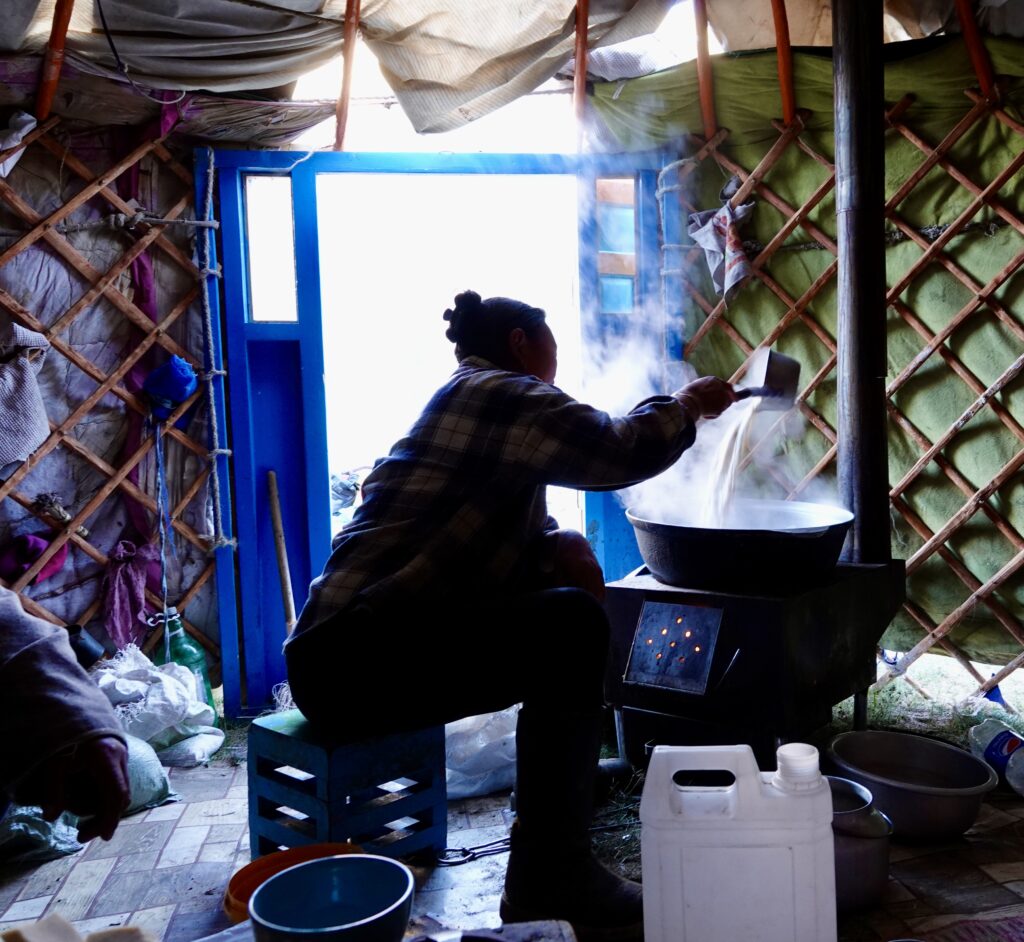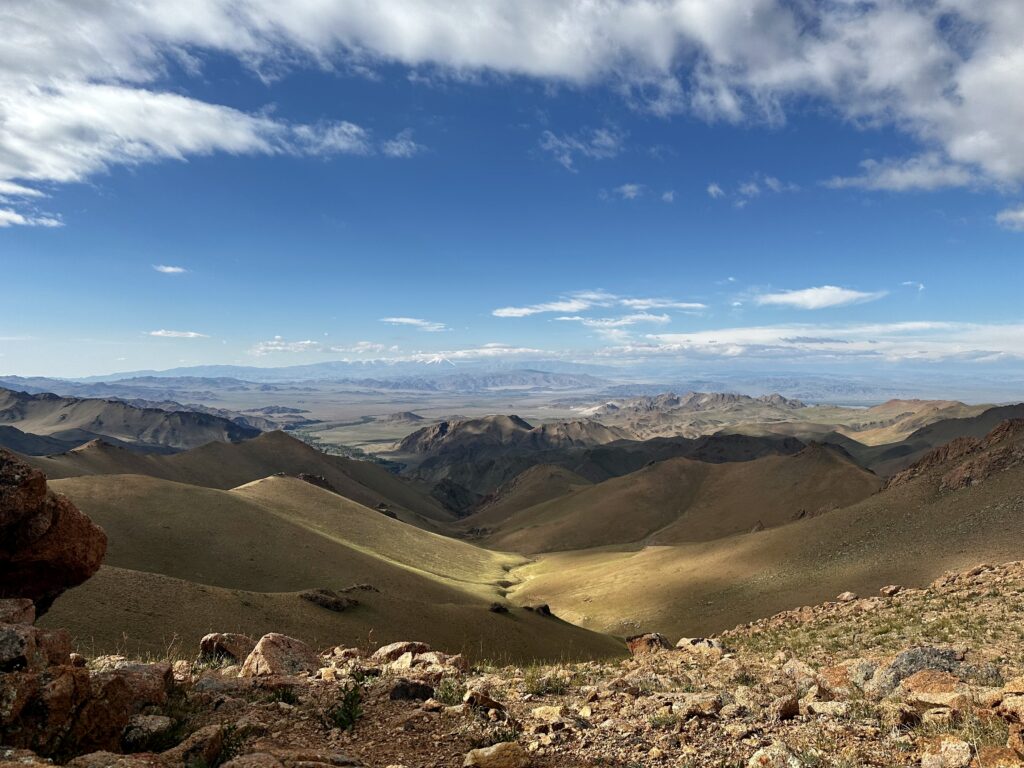Altai Time
The Long Journey to Hunt Ibex in Mongolia was a Blessing in Disguise
By Lowell Stevens III
Originally published in the November/December 2023 issue of Safari Magazine.
We met our guide and interpreter, Gala Galkhuu, in Ulaanbaatar, and went to collect our luggage for our Altai ibex hunt in Mongolia.
That’s when we learned my son Slade’s duffel didn’t make it. We had no choice but to get going, and we got into an SUV for a 25-hour drive across the country. Slade’s luggage eventually arrived two days later, delivered via a motorcycle. Driving across the country, we realized the canceled flight was a blessing in disguise. Mongolia was like nothing we had ever seen. We stopped frequently to let cattle, sheep, goats, horses, dogs and camels cross the road in front of us.
The first night we stayed in a quaint cabin by a lake where the owners prepared a dinner of mutton dumplings. We then joined a local family in their ger, a round tent insulated with skins and felt, for fermented mare’s milk, of which Gala had bought two liters. The smell was overpowering. I grew up around racehorses, but never considered drinking their milk, let alone throwing yeast in and letting it ferment.

The next afternoon we stopped along the road at an ovoo and enjoyed berries picked from the Hangai Mountains. Ovoos are large piles of stones used as geographical markers as well as Buddhist prayer sites.
Gala explained the history of Mongolia’s transition from shamanism to Buddhism, and how this shift diminished the country’s warrior mentality. He explained how to approach the monument and to pray for success on our hunt. Under his direction we circled the monument, tossing three stones on the pile that also contained colorful flags and offerings of food and money. Standing in that high-altitude silence in the presence of such history and reverence, I thought this must be what some people call a “thin” place. I felt God was close by.
After 21 hours on the roller-coaster-like highway, we turned on a dirt road. We assumed we were close, but Gala told us it was another three hours to camp. This “road” eventually faded to nothing, and we made three bridge-less river crossings before reaching camp.
We met our head guide and another local family and were welcomed with cheese curds and milk tea prepared over a dung-fueled fire. Our camp consisted of eight staff: a camp manager; his wife, who kept our ger tidy; a cook; two guides; a wrangler; our driver and Gala. In addition to them, there was a myriad of happy children. They laughed and hid whenever Slade took his camera out, playing a fun game of hide and seek. Mongolia’s people are welcoming, friendly and polite. The language barrier wasn’t an issue.
We soon learned the traditional Mongolian celebration of Naadam was about to take place, and the small camp buzzed with excitement. Naadam is a historic summer competition of archery, wrestling and horse racing. More than 2,000 nomadic herders gathered with their flocks for the festivities. It was an incredible opportunity to experience the tradition.
Our observance of Naadam only lasted a day as the next morning we set out to hunt the ibex we had come for. Waking well before daylight, we traveled to another ger where more horses and guides were waiting. Gala said something in Mongolian, and when he explained to us what it meant, I told him we say “riders up” in Kentucky. He laughed and said, “Well, riders up then.” He then used the term every time we mounted horses.
Slade and I were in awe of the mountainous landscape. The vastness was overwhelming. After an hour of riding, we arrived at the top of the tallest mountain and approached a high outcropping. We were at about 9,000 feet and could glass over almost the entire hunting area.

After spotting only a small group of young ibex, our guides rode to the next ridge with my spotting scope. Shortly thereafter, Gala asked if I was willing to take my ibex on the first day. I laughed and said, “Of course! First day, last day, any day.”
We rode to where the guides were and eased to the top, peering over the rocky ledge. I couldn’t believe my eyes. A mix of 45 young and mature billys sprawled out across the slope below us. It took a while to figure out which one I should take, but we all agreed on a beautiful old, white-necked billy with a long black beard and deep curling horns.
He was around 350 yards away, bedded with others who were stretched out in the warm morning sun. The wind was gusting, and I would have preferred to wait for him to stand. However, it was a clear quartering-to shot and I had a rock-steady mount. I waited for the wind to die and squeezed the trigger.
When the gun went off, I heard the bullet strike and the billy’s head dropped. Cheers, backslapping and congratulations erupted. Then Slade shouted, “His head’s up! He’s moving!” I quickly tried to get back in position, but it was already too late. He was trotting away.
I was in disbelief. I have rarely lost sight of a hit animal in my 46 years of big game hunting, but I knew it could happen and was mentally prepared. The guides didn’t seem too concerned, but I was. I prayed to God to help us find him. The head guide rode his horse to the highest point he could find and bounced from ridge to ridge over the next 45 minutes.
I quickly rode in the direction the ibex disappeared with my personal guide who kept in radio contact with the head guide. I had no idea what they were saying or if anyone had eyes on the animal.
After a long ride around the mountain searching and glassing, we were coming down a draw when my guide pointed to a cliff where the ibex was bedded. I couldn’t believe we found him. He was 200 yards away but quickly rose, walked over the crest and disappeared before I could get set up.
We jumped back on our horses and took off down the draw. I was doing my best to stay in the small saddle made of wood, leather and rebar, but it was difficult because the stirrups were so short my legs were bent at a 90-degree angle. I felt like an unprepared jockey, and hoped I would stay on the horse.
We pulled up at the base of another cliff, jumped off our horses and began climbing the rocky escarpment. As I reached the crest, out of breath, my guide peeked over the edge and with a frantic look on his face began motioning me to come up.
I eased my rifle up, and immediately saw my ibex standing broadside on a small brush-covered ledge 100 yards above us. He was looking straight at us. I knew I had to shoot quickly, and it took me only a few seconds to settle the crosshairs and pull the trigger.
He fell 70 feet off the ledge and didn’t move once he hit the ground. I knew the hunt was over and thanked God. The hunt only lasted one day, but it will be one of the most memorable, challenging and rewarding hunts I’ve ever experienced.
After thanking my guides, honoring the ibex, taking pictures and processing, we rode back to camp. It was a good thing the hunt only lasted a day. That night, Slade and I got terribly sick. I recognized the feeling immediately from a previous blue sheep hunt in Nepal — the dreaded “Delhi-belly.” It wasn’t a surprise after our diet of milk tea, fermented mare’s milk, mountain berries, local water, herder cheese curds and other rural Mongolian delicacies.
Slade’s luggage and fly rod arrived by motorcycle that night, and we spent the next day relaxing, fishing and using all the toilet paper in camp. Slade is an accomplished fly fisherman, and with his guidance, we caught grayling on nearly every cast in the crystal-clear alpine river. Everyone fished, including our cook who did a great job preparing a shore lunch with the catch.
The next day we started the long trip back to Ulaanbaatar. Gala has been a guide and interpreter for more than 30 years and is very knowledgeable about Mongolia. He wanted us to take our time driving back, and we spent a couple nights on the road seeing the incredible country, meeting his friends and learning about the history and culture of the area.
Along the way, Gala seemed to know everyone. We went to monasteries, museums, Hustai National Park and attended a Naadam event. The last day of the trip was spent in Ulaanbaatar. We bought Mongolian cashmere for our wives and visited the “Hunting Trophy Museum” where we had a private tour and saw the record Altai, Gobi and Hangai argali mounts as well as saiga antelope and snow leopard.
Shortly after Gala left us at the airport, I received a text from him.
“I was really happy hunting with you,” he wrote.
All I could think about was how grateful I was to have experienced all this with Slade. The journey opened our minds to a new world, leaving us with a deep respect for the culture, people and wildlife of Mongolia.
“Gala, we were really happy hunting with you, too,” was my response.
Lowell Stevens III is a Life member from Kentucky.

